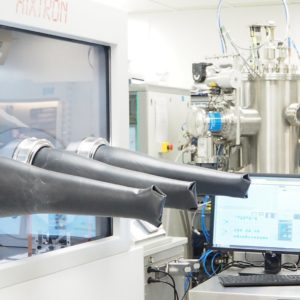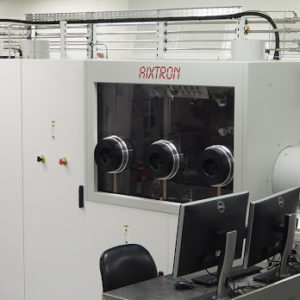Metal-Organic Vapour Phase Epitaxy (MOVPE)
The EPSRC National Epitaxy Facility can offer the full range of phosphide and arsenide based semiconductor materials by MOVPE to support a wide range of device structures for world leading semiconductor physics and engineering research in the UK, including both lattice matched and strained combinations of III-V epitaxial materials.
The Facility in Sheffield boasts two MOVPE reactors; a new state-of-the-art AIXTRON reactor featuring closed coupled showerhead (CCS) technology in a flip top chamber with 3 x 2”, 1 x 3” and 1 x 4” wafer capability, a Thomas Swan showerhead reactor (with fully automated robot loader) with 1 x 6”, 2 x 4”, 3 x 3” and 6 x 2” wafer capability.
A wide range of III-V epitaxial material is offered comprising gallium, aluminium, indium, arsenic, phosphorus plus silicon n-dopants and zinc and carbon p-dopants. Both lattice matched and strained combinations are available. Furthermore the Facility is currently developing capability for antimonides by MOVPE with a view to this being available to the semiconductor research community in the near future.
In support of epitaxy, the Facility also has extensive characterisation and device fabrication processing equipment. Recent investment to our Facility includes XRD, AFM, PL, LT-PL, ICP etcher, ICP-PECVD, O2 asher and rapid thermal annealing.
Structures and devices include:
- Edge and emitting and vertical cavity structures
- Disk VECSEL lasers
- Nanowires
- Epitaxial overgrowth structures
- Quantum dot and quantum well devices
- Quantum cascade lasers (a world first grown by MOVPE)
External characterisation capabilities include:
- High resolution X-Ray Diffraction (XRD)
- Photoluminescence (PL)
- PL mapping
- Atomic force microscopy (AFM)
- Nomarski optical microscopy
- Hall measurement
- Low temperature PL (LT-PL)
- Micro PL
- Electrochemical capacitance voltage (ECV)
- Scanning electron microscopy (SEM)
- Numerous other techniques provided by carefully selected external collaborators (e.g. SIMS, TEM, XPS, etc.)


